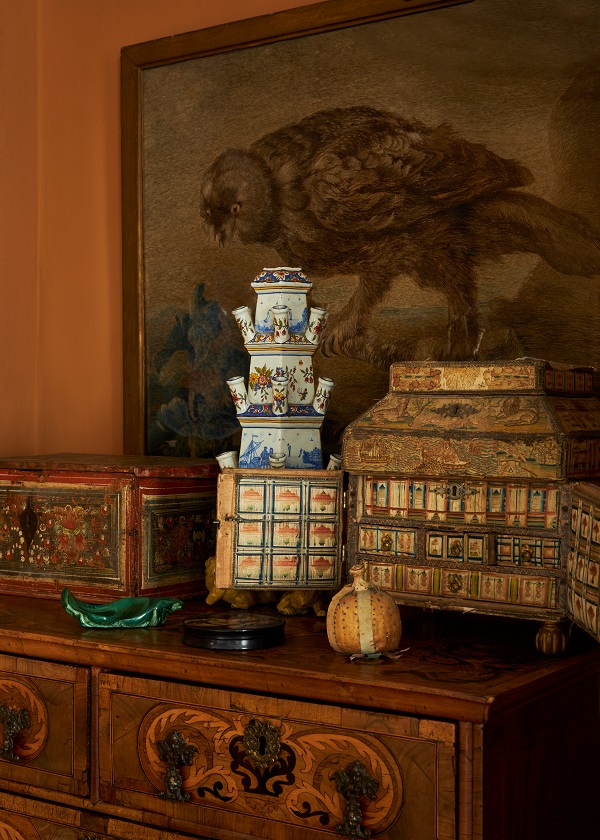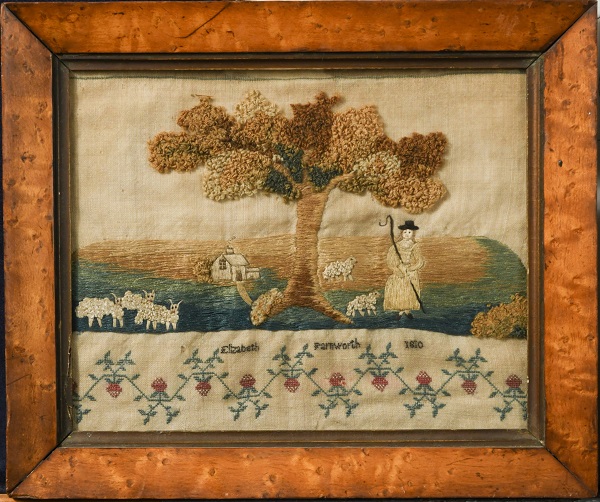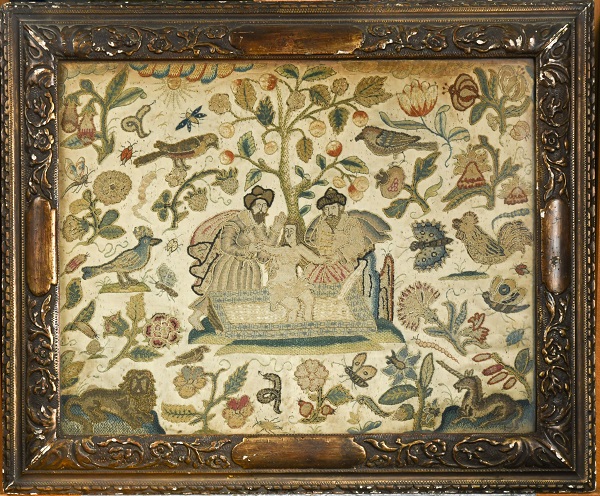Stumpwork, a form of raised embroidery usually dating from the late 17th and early 18th century, is making a comeback. While prices peaked in the nineties, popularity of this antique artform is back on the agenda for collectors, interior designers and embroidery fans up and down the country. These intricate pieces can be found in some of the most astute antique collections across the country, for example, Robert Kime was known to be a fan, whilst interior designers such as Benedict Foley also feature these textured works in projects.

A stumpwork casket and embroidered picture of an owl, featured in a collaboration between Cheffins and designer Benedict Foley in Suffolk
The popularity of stumpwork could well be running in parallel with the country’s newfound obsession with embroidery. The resurgence of this artform which peaked in the late 18th century, has had an impact all sectors of society. It’s featured in some of the newest fashion trend reports of 2023, with Etro sending pyjamas down the runway embroidered with florals, and Valentino’s embroidered bags being cited as some of the trends to watch.
On a more day to day level, embroidery also was brought to the masses over the past couple of years as an antidote to lockdown boredom. Brands such as The Fabled Thread, which sells ready made embroidery kits, now has a 37.8k-strong following on Instagram, whilst sellers such as Cloth Kits and Nancy Nicholson have a similar offering. Research from Google found that there was a 100% increase in searches for embroidery kits during lockdown, whilst the BBC’s The Great British Sewing Bee, was a runaway success, now going into its ninth season which will air later this year.
Promoted for its positive effects on mental wellbeing, and its ability to provide a distraction for many during these overstimulated times, embroidery’s popularity has trickled down to the auction room.
Some of the charm of these pieces, particularly the samplers which were more common in the late 18th and early 19th century, is that they were created by children. They were a tool to help teach literacy and numeracy and were seen as an essential part of girls’ education. Often detailing the names and ages of the maker, these naïve works have a real warmth to them and can bring another layer of texture to a room, whilst also being a great conversation piece.

An example of a 19th century embroidery picture, dated 1810, available as part of The Fine Sale on 22nd and 23rd March
Traditionally this was always a very academic collecting field, bought by the most astute collectors and dealers, with prices really hitting their peak in the nineties. Whilst values took a dip in recent years, the market seems to have found a new appreciation for these incredibly intricate works. Values have always been high for the best in class of these pieces, particularly as they are prone to sun damage and decay, and the number of really fabulous examples still in existence is on the decline. As the availability falls away, and interior tastes turn to the more traditional, prices are rising and have certainly remained more robust than many other antiques.
A good example would be a 17th century stumpwork panel which was sold at Cheffins in 2018, this made £24,000 against an estimate of £3,000 - £5,000, as it was a quality piece, with great provenance. Other stumpwork pieces, including boxes, caskets or frames are also incredibly sought after, with a Charles II casket selling for £3,200 in 2021, (pictured above) against an estimate of £1,200.
In March, we will be offering a series of stumpwork pieces sourced from an antiques collector based in the Cotswolds. These present a great opportunity for embroidery and stumpwork fans to make a first foray into this market. The most important consideration for first time buyers of embroidery and stumpwork is to really look at the condition. These are incredibly delicate pieces, prone to sun damage, mould or even pests such as clothes moths. Light causes huge damage to textiles and can fade colours and break down fibres, so any buyers of these pieces would do well to ensure that they don’t hang their new piece in direct sunlight, or under a spotlight. Similarly, extreme temperature fluctuations can be damaging, as can heat or humidity, so positions directly above radiators should be avoided.

An example stumpwork picture from a Burford-based collection, available as part of The Fine Sale on 22nd and 23rd March
For anyone looking to find out more about the history of embroidery, the V&A is currently hosting an exhibition, ‘Embroidery – a history of needlework samplers’ in which the museum is showing over 700 examples, dating back as early as the 1400s.
To view the full auction calendar for 2023, please click here, or contact the Fine Art Department on 01223 213343 or email fine.art@cheffins.co.uk